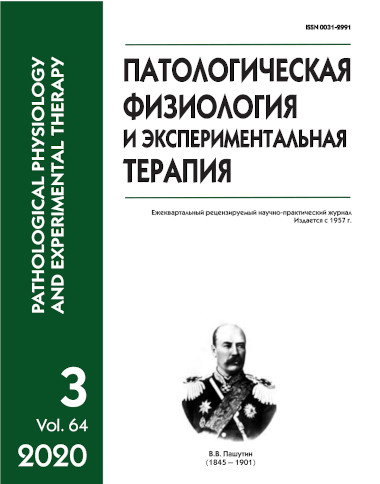Cytokine profile and antibodies to neurotransmitters during comorbid depression and alcohol dependence in women
Abstract
Aim. Comparative analysis of concentrations of pro- and anti-inflammatory cytokines and autoantibodies to the neurotransmitters dopamine, norepinephrine, 5-hydroxytryptamine, glutamate, and GABA in the blood serum of female patients with alcohol dependence and depression of different severity. Methods. Clinical examination and creation of a bank of biological material were performed at the Departments of Affective Disorders and Addictive Conditions and the Laboratory of Clinical Psychoneuroimmunology and Neurobiology of the Mental Health Institute, Tomsk Scientific Research Center of the Russian Academy of Sciences. Blood serum of 52 women aged 40-55 years was studied, including 17 conditionally healthy individuals, and 35 patients with affective and addictive disorders. In accordance with ICD-10, 6 patients were diagnosed with alcohol dependence syndrome (F10.2), and 29 patients were diagnosed with depression of different severity. The subgroup of mild depression with a Hamilton Depression Rating Scale (HDRS) score <16 included 13 patients (5 with a mild depressive episode F32.0 and 8 with dysthymic disorder F34.1). The subgroup of moderate depression with a total HDRS score >16 included 16 patients (7 with a moderate depressive episode F32.1 and 9 with recurrent depression F33.1). Serum antibodies to the neurotransmitters dopamine (DA), norepinephrine (NA), 5-hydroxytryptamine (5-HT), glutamate (GLU), and GABA were determined by enzyme-linked immunosorbent assay (ELISA) on polystyrene plates activated with the respective test antigens. Serum interleukins (IL) were measured using ELISA test systems. The balance of pro-inflammatory (IL 1β and IL 6) and anti-inflammatory (IL 10) cytokines was determined. Statistical analysis was performed with the φ Fisher criteria, and data were graphically presented as mean values. Results. Concentrations of autoantibodies to neurotransmitters were related with the severity of depression. In mild depression, differences from the control values were negligible. In moderate depression, levels of antibodies to 5-hydroxytryptamine, glutamate, and GABA were increased. In alcohol dependence, the array of antibodies was similar to that in moderate depression. These patterns apparently reflect the comorbid course of depression and addiction. The ratio of pro-inflammatory (IL 6) to anti-inflammatory (IL 10) cytokine serum concentrations in alcohol dependence was slightly different from the control ratio. At the same time in more severe depression, this ratio significantly increased and clearly indicated prevalence of inflammation over compensatory processes in 20% of the patients. Conclusion. The phenomenon of neuroinflammation is not sufficient to understand neuroimmune mechanisms of the comorbid pathology. Immunoregulation of neurotransmitter metabolism is a new source of information about neuroimmune imbalance in combined disorders.






